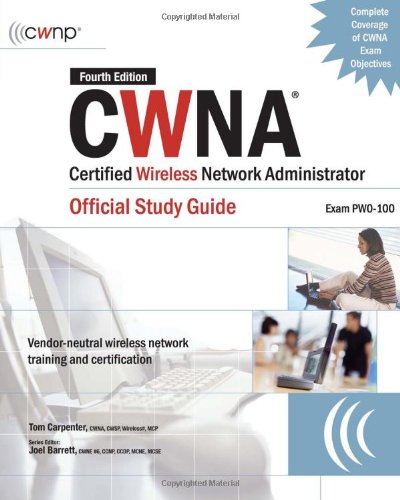

Most ebook files are in PDF format, so you can easily read them using various software such as Foxit Reader or directly on the Google Chrome browser.
Some ebook files are released by publishers in other formats such as .awz, .mobi, .epub, .fb2, etc. You may need to install specific software to read these formats on mobile/PC, such as Calibre.
Please read the tutorial at this link. https://ebooknice.com/page/post?id=faq
We offer FREE conversion to the popular formats you request; however, this may take some time. Therefore, right after payment, please email us, and we will try to provide the service as quickly as possible.
For some exceptional file formats or broken links (if any), please refrain from opening any disputes. Instead, email us first, and we will try to assist within a maximum of 6 hours.
EbookNice Team

Status:
Available4.8
7 reviews
ISBN 10: 0071494901
ISBN 13: 9780071494908
Author: Tom Carpenter, Joel Barrett
The only official study guide for CWNA Exam PW0-100 Fully authorized by the exam developers at the CWNP program, this comprehensive study guide thoroughly covers all the topics on the CWNA certification exam. Work at your own pace through a system of lessons, scenarios, and review questions to learn the material quickly and easily. CWNA Certified Wireless Network Administrator Official Study Guide will help you prepare for the exam by showing you, step-by-step, how to implement, troubleshoot, and maintain wireless LANs. Get the only study guide endorsed by the creators of the CWNA exam and start your career as an expert wireless network administrator. Maximize your performance on the exam by learning: Wireless Standards, Organizations, and Applications Radio Frequency and Antenna Fundamentals Spread Spectrum Technologies IEEE 802.11 WLAN Design Models, Topologies, and Infrastructure Site Surveying and Network Planning Infrastructure and Client Hardware and Software Security Troubleshooting Complete Exam Coverage Comprehensive details on all CWNA exam objectives Review questions modeled after the real exam Helpful chapter summaries and key term lists Vendor-neutral coverage of wireless technologies and equipment
Part I: Understanding Wireless Technologies
Chapter 1: Wireless Standards, Organizations, and Applications
Roles Organizations Play Within the WLAN Industry
Regulatory Domain Governing Bodies: ITU-R, IEEE, IETF, Wi-Fi Alliance
Spread Spectrum Technology Uses
Wireless LANs, PANs, MANs, WANs
Wireless LAN Technology Roles: Corporate Data, Network Extension, SOHO, Education, Health Care, Hotspots
Summary, Key Terms, Review Questions
Chapter 2: Radio Frequency and Antenna Fundamentals
Electromagnetic Waves: History, Fundamentals, RF Characteristics, Behavior
Gain, Loss, Reflection, Refraction, Diffraction, Scattering, Absorption
VSWR, Return Loss, Amplification, Attenuation
Wave Propagation, Multipath, Delay Spread
Basic RF Math, Link Budget, System Operating Margin, Fade Margin
Antenna Concepts: LOS, Fresnel Zone, Beamwidth, Polarization, Diversity
Antennas and Antenna Systems: Omnidirectional, Semidirectional, Highly Directional, MIMO
Summary, Key Terms, Review Questions
Chapter 3: Spread Spectrum Technologies
OSI Model Overview
Spread Spectrum vs Narrowband Technology: FHSS, DSSS, HR/DSSS, OFDM, IEEE 802.11n
Modulation, Coding, Dwell Time, Carrier Frequencies, Colocation, Throughput vs Data Rate
Summary, Key Terms, Review Questions
Chapter 4: IEEE 802.11 In Depth
Terminology Review, Frames, Packets, Datagrams
MAC & PHY, CSMA/CA, Frame Types, State Machine, Authentication, Association
Data Flow Optimization: DCF, PCF, IEEE 802.11e/WMM, RTS/CTS, Fragmentation, Dynamic Rate Switching
Summary, Key Terms, Review Questions
Part II: Deploying Wireless LANs
Chapter 5: Wireless Design Models, Topologies, and Infrastructure
WLAN Service Sets: BSS, ESS, Ad Hoc/IBSS, Infrastructure Mode
Distribution System, Roaming, WLAN Design Models, Mesh Networks
WLAN Power Management: Active/Power Save, WMM Power Save, TIM/DTIM/ATIM
Summary, Key Terms, Review Questions
Chapter 6: Site Surveys and Network Planning
Physical and RF Site Surveys: Preparation, Documentation, Business Requirements, Permits
Manual and Automated Site Surveys: Tools, Virtual Surveys, Verification
Considerations: Interference, Connectivity, Coverage, Voice, Client Requirements
Implementation Plan, Site Survey Tools (Aruba, Trapeze Networks)
Summary, Key Terms, Review Questions
Chapter 7: Infrastructure Hardware and Software
WLAN Devices: Access Points, Switches/Controllers, PoE, Bridges, Gateways, Mesh Routers
WLAN Solutions: Manageability, Technology Convergence, Data Rates, Voice (VoWLAN), Location Tracking
WLAN Accessories: Amplifiers, Attenuators, Lightning Arrestors, Towers, RF Cables, Connectors, Antenna Installation
Summary, Key Terms, Review Questions
Chapter 8: Client Devices and Software
WLAN Client Internals, Installing/Configuring Clients: PC Cards, USB/CF/SD, PCI, Wireless Gateways
Drivers, Software, Connecting to WLAN
Summary, Key Terms, Review Questions
Part III: Securing Wireless LANs
Chapter 9: Wireless Vulnerabilities and Attack Methods
Eavesdropping, Hijacking, DoS, Management Exploits, Encryption/Authentication Cracking, MAC Spoofing
Peer-to-Peer Attacks, Social Engineering, General Security Principles (CIA, AAA)
Summary, Key Terms, Review Questions
Chapter 10: Designing and Implementing Security for Wireless LANs
IEEE 802.11 Security: Pre-RSNA, RSNA, AAA Components
WLAN Client Security: Role-Based Access, Profile-Based Firewalls, NAC, Captive Portals, IPsec VPN
System Security: SNMPv3, HTTPS, SSH2, Rogue AP Detection, Policy Elements, Advanced Security Topics (VLANs, Layered Security)
Summary, Key Terms, Review Questions
cwna certified wireless network administrator
cwna certified wireless network administrator study guide
cwna wireless
cwna ebook
cwna book amazon
Tags: Tom Carpenter, Joel Barrett, CWNA, Wireless